Tom's Hardware Verdict
If you’re looking for reliable speed in a value-priced gaming monitor, the AOC CQ27G2 is well worth looking at. It delivers 144 Hz, both kinds of Adaptive-Sync and excellent contrast. Though it leaves out HDR, you won’t miss that feature when you see its saturated picture and deep blacks. Highly Recommended.
Pros
- +
Contrast
- +
Accurate color
- +
144 Hz
- +
FreeSync & G-Sync
- +
Accurate sRGB mode
- +
Value
Cons
- -
No USB ports
- -
No speakers
- -
Less bright than others in its class
Why you can trust Tom's Hardware
The 27-inch 1440p (aka QHD) 144 Hz category is red hot for those seeking the best gaming monitors right now with 57 choices available at one online retailer alone. It’s no wonder, because there is no better way to maximize performance for an affordable low price. Things like Adaptive-Sync and extended color have become commodities too and those features are a minimum for manufacturers that want to compete in this genre.
With both flat and curved panels selling for under $300, the choice comes down to small differences in performance. We’re looking for high contrast, reliable video processing and solid build quality. AOC’s CQ27G2 appears to meet those expectations with a 27-inch QHD/VA panel, gently curved to a 1500mm radius. It features 144 Hz, Adaptive-Sync, extended color and excellent contrast.
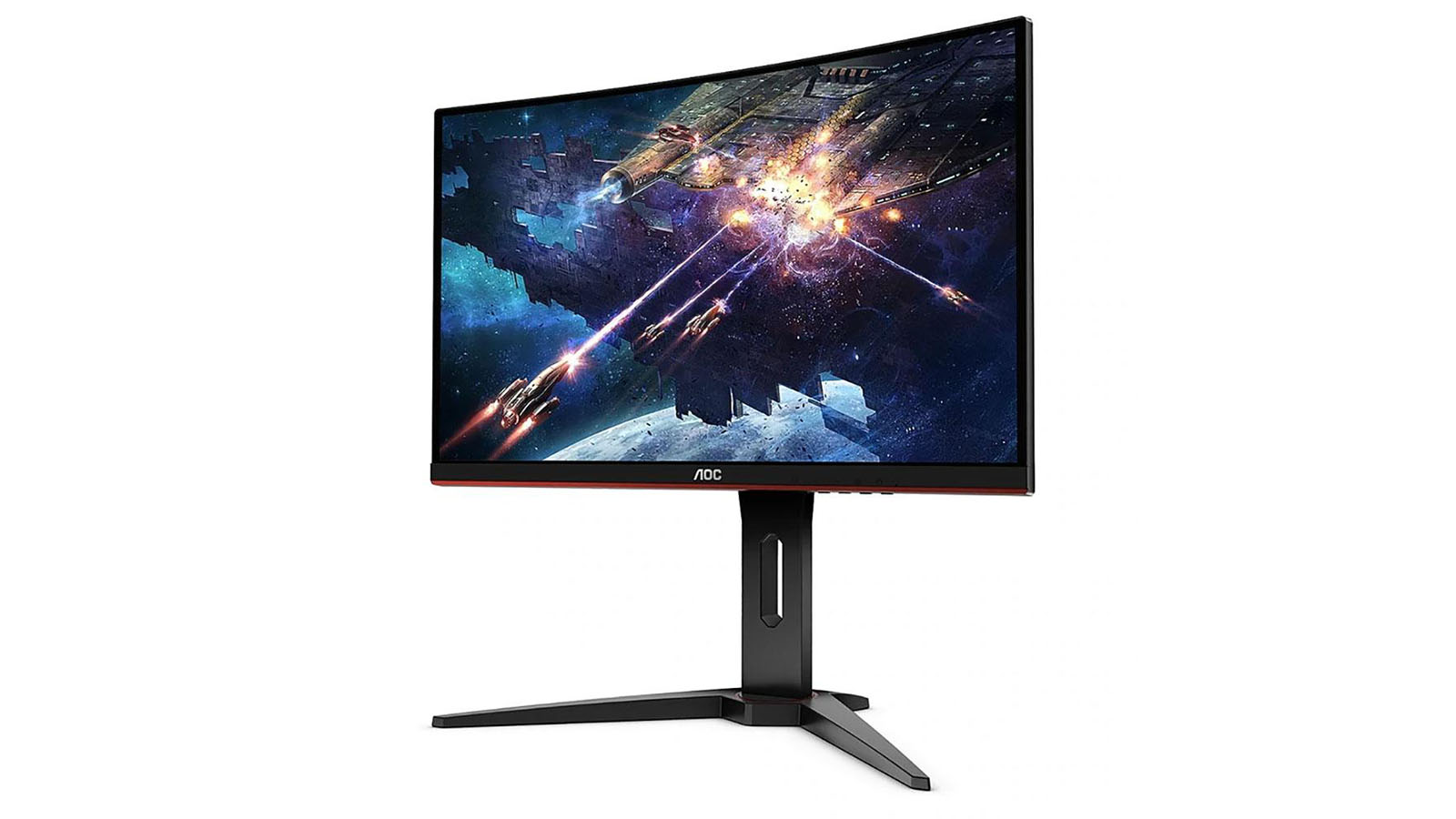
AOC CQ27G2 Specifications
| Panel Type & Backlight | VA / W-LED, edge array |
| Screen Size & Aspect Ratio | 27 inches / 16:9 |
| Row 2 - Cell 0 | Curve radius: 1,500mm |
| Max Resolution & Refresh | 2560 x 1440 @ 144 Hz |
| Row 4 - Cell 0 | FreeSync: 48-144 Hz |
| Native Color Depth & Gamut | 8-bit / DCI-P3 |
| Response Time (GTG) | 1ms |
| Brightness | 250 nits |
| Contrast | 3,000:1 |
| Speakers | None |
| Video Inputs | 1x DisplayPort 1.2 |
| Row 11 - Cell 0 | 2x HDMI 2.0 |
| Audio | 3.5mm headphone output |
| USB 3.0 | None |
| Power Consumption | 25.7w, brightness @ 200 nits |
| Panel Dimensions WxHxD w/base | 24.1 x 15.7-20.8 x 9 inches (612 x 399-528 x 229mm) |
| Panel Thickness | 2.9 inches (73mm) |
| Bezel Width | Top/sides: 0.3 inch (8mm) |
| Row 18 - Cell 0 | Bottom: 0.8 inch (21mm) |
| Weight | 11.9 pounds (5.4kg) |
| Warranty | 3 years |
Contrast is always our top consideration when reviewing monitors and any display with a VA panel already has an advantage. You can expect at least double the dynamic range of an IPS or TN screen and sometimes even triple, like the AOC CQ27G2. Though it doesn’t include HDR, it delivers a very high contrast ratio over 3600:1 right out of the box. It is a bit less bright than most of its competition at a rated 250 nits but its killer black levels more than make up for that.
The image is further enhanced by extended color. By our measurements, the CQ27G2 covers almost 83% of the DCI-P3 gamut. That’s not as much as some others but it is enough to make a visible impact. And color purists will rejoice in its accurate and usable sRGB mode. Precision is not a problem here as we found it qualified for our calibration-not-required list.
The CQ27G2 is a curved monitor though you’d barely notice when looking at it. The radius is very gentle at 1500mm with a 16:9 aspect ratio. In practice, the curve neither enhances nor detracts from the image. Gamers might find it useful though.
Of course, video processing is a priority too and that is amply covered by a reliable 144 Hz refresh rate, achieved without overclock, and Adaptive-Sync. FreeSync is the native tech and we verified G-Sync compatibility in our tests. The CQ27G2 has not been certified by Nvidia.
Gaming features include a three-level overdrive and motion blur reduction courtesy of a backlight strobe. Like most gaming monitors, you must pick between the strobe and Adaptive-Sync; you can’t use them together. There are 20 levels of blur reduction controlled by a slider; less blur means less light output. You also get a frame rate counter and an aiming point.
Get Tom's Hardware's best news and in-depth reviews, straight to your inbox.
Assembly & Accessories
The CQ27G2 goes together easily without tools. Attach the base to the upright, then snap the stand in place. If you’d rather use an arm, there is a 100mm VESA mount provided; you’ll need to source your own bolts though. AOC includes HDMI and DisplayPort cables along with an IEC cord for the internal power supply.
Product 360

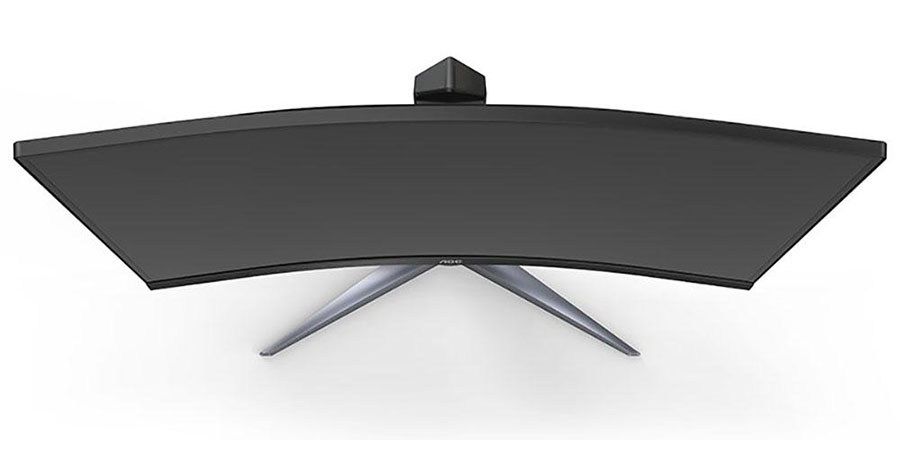
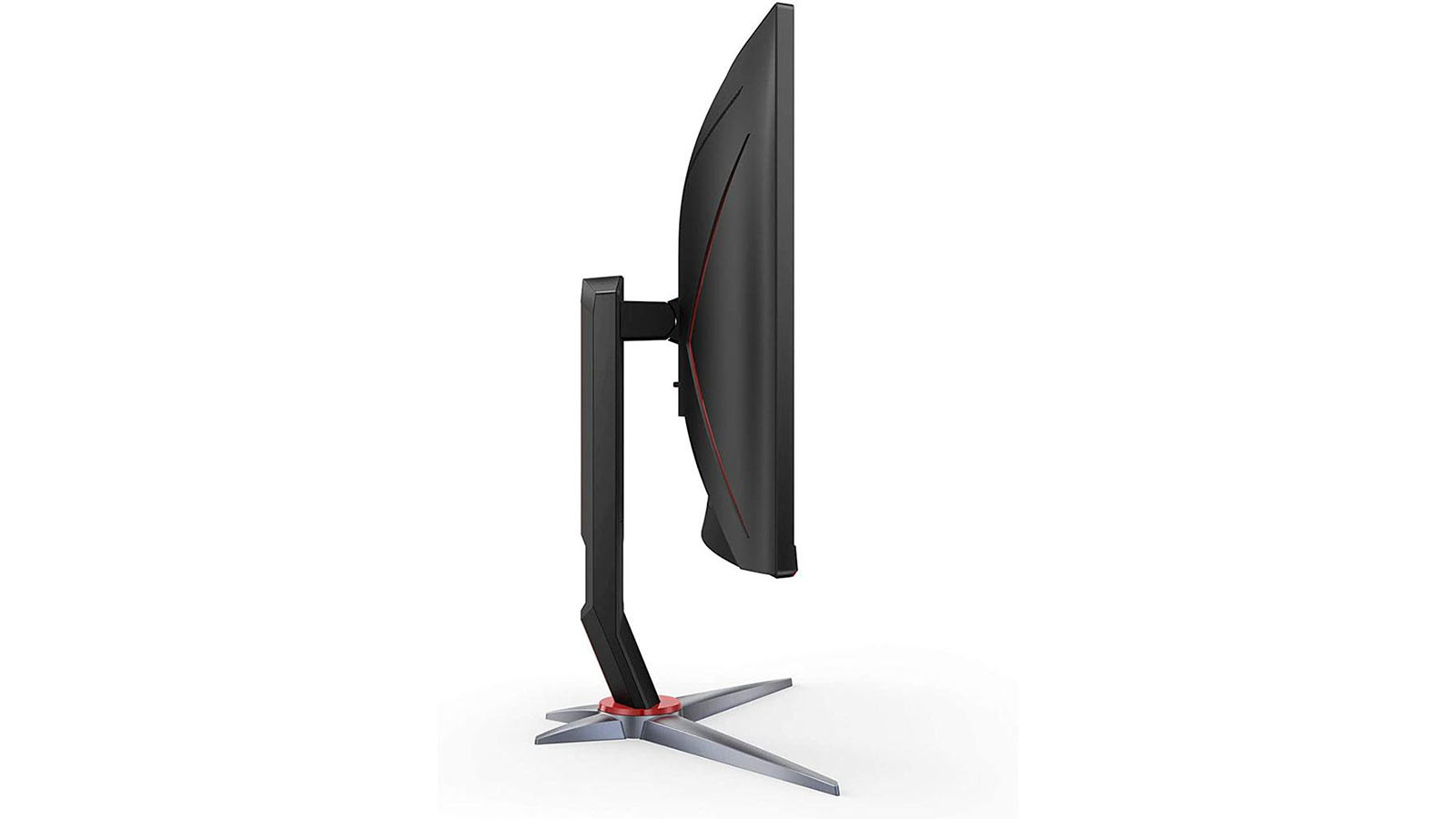
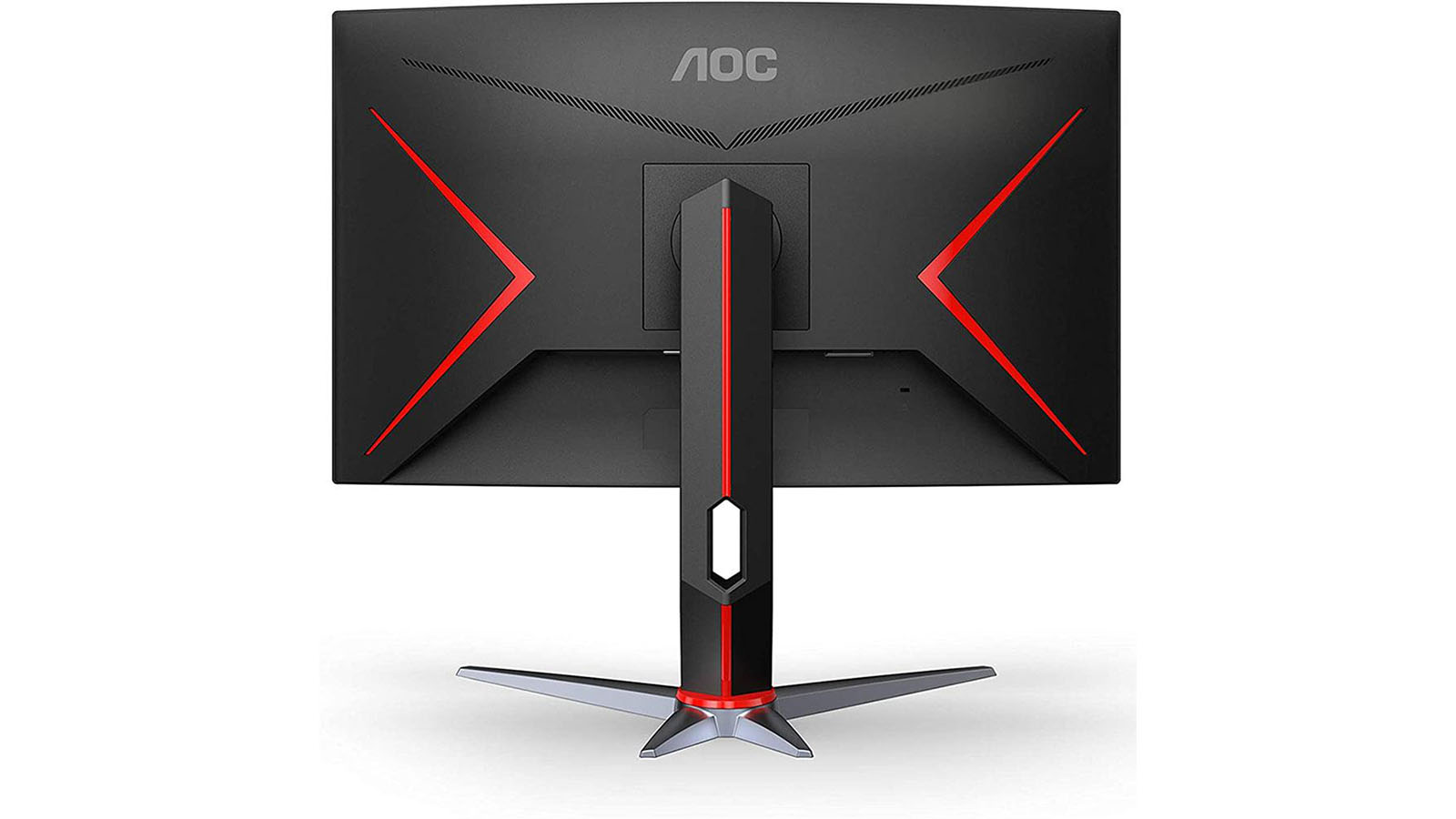
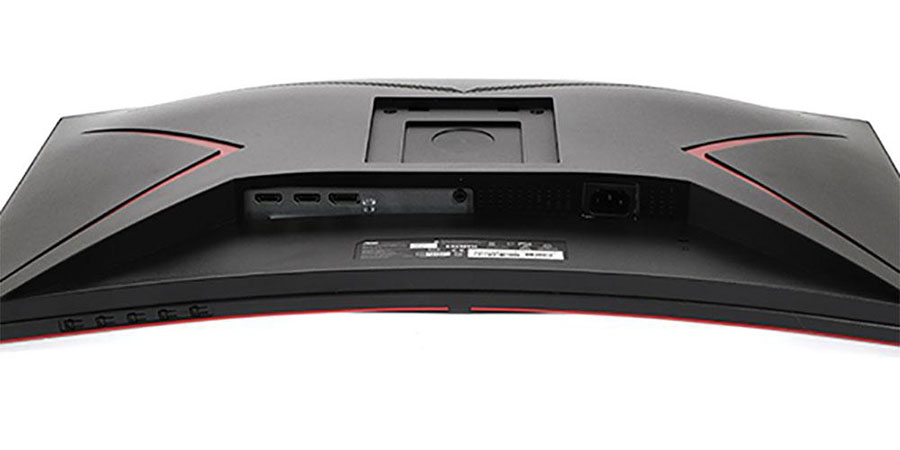
The CQ27G2 features basic styling that will appeal to gamers and general users equally well. Red trim is used sparingly across the front, at the base and in back to break up the monotony of black plastic. The base is covered in a silvery-gray plastic with sharp angles. Aside from the panel’s curve, you won’t find any roundness here. The anti-glare layer is effective in its purpose and tightly fitted for a clear grain-free image.
The stand offers a 5.1-inch height adjustment with 30° swivel to both sides and 5/23° of tilt. There is no portrait mode, not unusual for a curved monitor. Movements are firm and have a quality feel; there is no play or wobble here.
In back, you can see more red trim on the panel and upright. A narrow grill provides a styling cue and ample ventilation for internal components. Heat was no problem with our CQ27G2 sample. The side profile is reasonably thin, about what you’d expect for such a gently curved monitor. There are no USB ports or built-in speakers.
Underneath the panel’s center is an input panel with two HDMI 2.0 and a single DisplayPort 1.2. A 3.5mm audio output supports headphones or powered speakers.
OSD Features
The CQ27G2’s OSD is controlled with four tiny buttons just right of center under the bezel. They are difficult to use, especially when you’ve been spoiled by the joysticks that are becoming commonplace. And it’s too easy to click the power toggle by mistake. Pressing the fourth key brings up AOC’s familiar strip-style menu with six sections.

The Luminance menu has brightness and contrast sliders along with three gamma presets, a dynamic contrast toggle and an HDR Effect mode that simulates HDR. The CQ27G2 does not support HDR10 signals but some users may prefer the look it provides. There are three modes available that manipulate different parts of the brightness range. We left it off for our review. There is plenty of contrast available already. Also here are the Eco Modes (picture presets). There are seven choices, but you’ll want to stick with Standard; it’s the default and best option.

In Color Setup, you can choose from three color temp presets or adjust the sliders for a precise calibration. Here is where you’ll find the sRGB mode; it’s in the color temp list. Engaging it gives you a very accurate grayscale and correct coverage of the sRGB gamut. It’s one of the better sRGB modes we’ve seen from an extended color monitor.

Game Setting has more picture modes though we found the best image with Game Mode turned off. You can adjust Shadow Control for more visible dark detail and color saturation. There’s a low blue light mode for reading here too. Video processing options include a three-level overdrive, Adaptive-Sync toggle and motion blur reduction. It’s grayed out in the photo but when you turn off Adaptive-Sync, it comes on with a 20-level slider control. Higher settings reduce what little blur there is but also reduce brightness.
If you’re looking for the aiming point, press the third button from the left. You get a single choice, a red circle with a crosshair inside.
AOC CQ27G2 Calibration Settings
The AOC CQ27G2’s Standard mode delivers excellent accuracy with only tiny grayscale errors and nearly 83% coverage of the DCI-P3 gamut. Gamma is a bit light, so we changed the preset from 1 to 3. By tweaking the RGB sliders and lowering contrast two clicks, we improved the image with a visible gain in depth and color saturation. Though we used the full native gamut for our hands-on tests, there is an excellent sRGB mode that has spot-on grayscale and color tracking. We left the HDR Effect and Game Mode options off. Here are the settings we used.
| Picture Mode | Standard |
| Brightness 200 nits | 96 |
| Brightness 120 nits | 49 |
| Brightness 100 nits | 36 |
| Brightness 100 nits | 25 |
| Brightness 50 nits | 7 (minimum 39 nits) |
| Contrast | 48 |
| Gamma | 3 |
| Color Temp User | Red 47, Green 51, Blue 48 |
Gaming & Hands-on
For general use, a 27-inch monitor like the AOC CQ27G2 strikes a good balance of size and usable screen area. It doesn’t take up a lot of room on the desktop but provides plenty of space for documents. The thin bezel and low price means putting two screens together is a reasonable can be done without breaking the budget. Photo editing where the graphic sits on one panel and your tools and utilities sit on the other is a very efficient way to work.
The CQ27G2’s contrast makes it a great choice for all kinds of tasks. Black text on white backgrounds is easy to read even at small sizes. With 109ppi pixel density, you’ll have to get within inches of the screen to see jagged lines or individual pixels. Any kind of graphic, static or moving, is rendered in rich hues with accurate color and plenty of depth. Blacks are true and textural elements look three-dimensional.
We went straight for Tomb Raider and its tropical world of jungles and caves. Earth tones are warm and realistic while plants and trees sway convincingly in the breeze. We maintained 130-140 fps for most gameplay with peaks at 144. Detail was set to maximum and we defy anyone to see a difference between the CQ27G2 and a 4K IPS screen. 3400:1 contrast will make any image look sharper.
The color palette looks a little richer than the game’s creators intended but we didn’t mind. We tried the sRGB mode for a few hours and found it just as pleasing to look at. It’s very accurate and should appeal to color purists. But we suspect most users will stick to the Standard picture mode and Warm color temp. Just be sure to change gamma from 1 to 3 for maximum color saturation.
Call of Duty WWII delivered a similar experience. Though we couldn’t try out its HDR mode, it looks quite fine when played on an extended color monitor in SDR. VA technology produces enough contrast to make one forget about HDR. It would take a much more expensive display with a full-array local-dimming backlight to see better image quality than this.
In all gaming scenarios, video processing was ideal. Adaptive-Sync worked on both AMD and Nvidia platforms with equal reliability. We never saw a frame tear. Low Framerate Compensation is clearly in play here as there was no image breakup when we viewed test patterns below 48 fps. The overdrive works very well on its highest setting. We didn’t see any ghosting and motion blur was minimal. You can achieve perfect smoothness by turning on the backlight strobe in the Game Setting menu, but this will produce occasional tears as Adaptive-Sync must be turned off. During fast-paced action, blur was never a distraction and motion resolution stayed crisp. We recommend sticking with FreeSync or G-Sync.

Christian Eberle is a Contributing Editor for Tom's Hardware US. He's a veteran reviewer of A/V equipment, specializing in monitors. Christian began his obsession with tech when he built his first PC in 1991, a 286 running DOS 3.0 at a blazing 12MHz. In 2006, he undertook training from the Imaging Science Foundation in video calibration and testing and thus started a passion for precise imaging that persists to this day. He is also a professional musician with a degree from the New England Conservatory as a classical bassoonist which he used to good effect as a performer with the West Point Army Band from 1987 to 2013. He enjoys watching movies and listening to high-end audio in his custom-built home theater and can be seen riding trails near his home on a race-ready ICE VTX recumbent trike. Christian enjoys the endless summer in Florida where he lives with his wife and Chihuahua and plays with orchestras around the state.
-
Spoiler000001 "FreeSync & G-Sync"Reply
"G-SYNC" and "G-SYNC Compatible" are two different things, this monitor does not have G-SYNC.